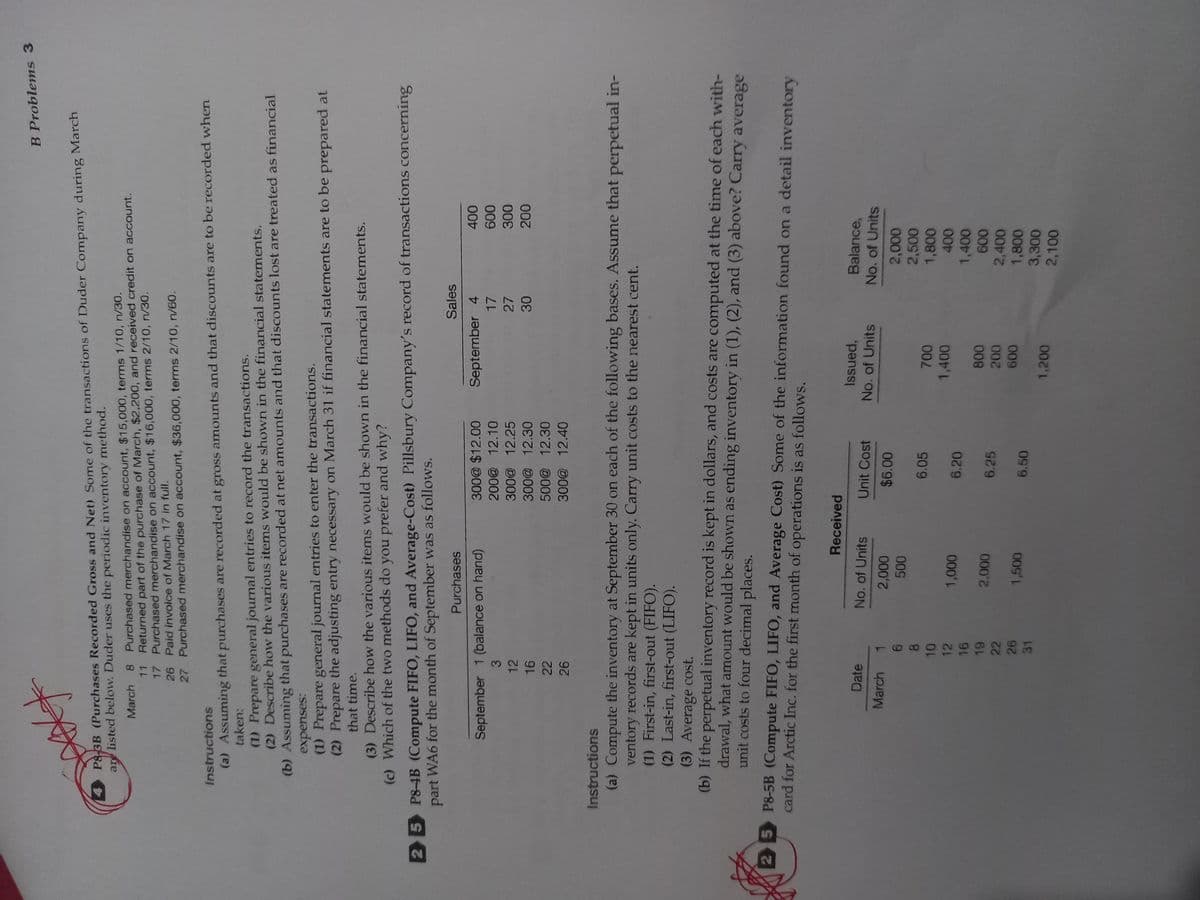B Pro 4 Pa-3B (Purchases Recorded Gross and Net) Some of the transactions of Duder Company during March ar listed below. Duder uses the periodic inventory method. 8 Purchased merchandise on account, $15,000, terms 1/10, n/30. 11 Returned part of the purchase of March, $2.200, and received credit on account. 17 Purchased merchandise on account, $16,000, terms 2/10, n/30. 26 Paid invoice of March 17 in full. 27 Purchased merchandise on account, $36,000, terms 2/10, n/60. March Instructions (a) Assuming that purchases are recorded at gross amounts and that discounts are to be recorded when taken: (1) Prepare general journal entries to record the transactions. (2) Describe how the various items would be shown in the financial statements. (b) Assuming that purchases are recorded at net amounts and that discounts lost are treated as financial expenses: (1) Prepare general journal entries to enter the transactions. (2) Prepare the adjusting entry necessary on March 31 if financial statements are to be prepared at that time. (3) Describe how the various items would be shown in the financial statements. (c) Which of the two methods do you prefer and why? 5 P8-4B (Compute FIFO, LIFO, and Average-Cost) Pillsbury Company's record of transactions concerning part WA6 for the month of September was as follows.
B Pro 4 Pa-3B (Purchases Recorded Gross and Net) Some of the transactions of Duder Company during March ar listed below. Duder uses the periodic inventory method. 8 Purchased merchandise on account, $15,000, terms 1/10, n/30. 11 Returned part of the purchase of March, $2.200, and received credit on account. 17 Purchased merchandise on account, $16,000, terms 2/10, n/30. 26 Paid invoice of March 17 in full. 27 Purchased merchandise on account, $36,000, terms 2/10, n/60. March Instructions (a) Assuming that purchases are recorded at gross amounts and that discounts are to be recorded when taken: (1) Prepare general journal entries to record the transactions. (2) Describe how the various items would be shown in the financial statements. (b) Assuming that purchases are recorded at net amounts and that discounts lost are treated as financial expenses: (1) Prepare general journal entries to enter the transactions. (2) Prepare the adjusting entry necessary on March 31 if financial statements are to be prepared at that time. (3) Describe how the various items would be shown in the financial statements. (c) Which of the two methods do you prefer and why? 5 P8-4B (Compute FIFO, LIFO, and Average-Cost) Pillsbury Company's record of transactions concerning part WA6 for the month of September was as follows.
Survey of Accounting (Accounting I)
8th Edition
ISBN:9781305961883
Author:Carl Warren
Publisher:Carl Warren
Chapter4: Accounting For Retail Operations
Section: Chapter Questions
Problem 4.2P: Sales-related transactions The- following selected transactions were completed by Affordable...
Related questions
Question

Transcribed Image Text:B Problems 3
P&-3B (Purchases Recorded Gross and Net) Some of the transactions of Duder Company during March
4.
ar listed below. Duder uses the periodic inventory method.
11 Returned part of the purchase of March, $2,200, and received credit on account.
17 Purchased merchandise on account, $16,000, terms 2/10, n/30.
March 8 Purchased merchandise on account, $15,000, terms 1/10, n/30.
26 Paid invoice of March 17 in full.
27 Purchased merchandise on account, $36,000, terms 2/10, n/60.
(a) Assuming that purchases are recorded at gross amounts and that discounts are to be recorded when
taken:
Instructions
(1) Prepare general journal entries to record the transactions.
(2) Describe how the various items would be shown in the financial statements.
(b) Assuming that purchases are recorded at net amounts and that discounts lost are treated as financial
expenses:
(1) Prepare general journal entries to enter the transactions.
(2) Prepare the adjusting entry necessary on March 31 if financial statements are to be prepared at
that time.
(3) Describe how the various items would be shown in the financial statements.
(c) Which of the two methods do you prefer and why?
25 P8-4B (Compute FIFO, LIFO, and Average-Cost) Pillsbury Company's record of transactions concerning
part WA6 for the month of September was as follows.
Sales
Purchases
September 1 (balance on hand)
3
300@ $12.00
200@ 12.10
September 4
17
12
300@ 12.25
27
300@ 12.30
22
500@ 12.30
300@ 12.40
Instructions
(a) Compute the inventory at September 30 on each of the following bases. Assume that perpetual in-
ventory records are kept in units only. Carry unit costs to the nearest cent.
(1) First-in, first-out (FIFO).
(2) Last-in, first-out (LIFO).
(3) Average cost.
(b) If the perpetual inventory record is kept in dollars, and costs are computed at the time of each with-
drawal, what amount would be shown as ending inventory in (1), (2), and (3) above? Carry average
unit costs to four decimal places.
25 P8-5B (Compute FIFO, LIFO, and Average Cost) Some of the information found on a detail inventory
card for Arctic Inc. for the first month of operations is as follows.
Received
Issued,
No. of Units
Balance,
No. of Units
Date
No. of Units
Unit Cost
March
1.
$6.00
2,000
2,500
1,800
to 00
9.
8.
6.05
12
1,400
6.20
1,400
009
2,400
6.25
22
to w00
200
1,800
3,300
2,100
6.50
31
1,200
Expert Solution
This question has been solved!
Explore an expertly crafted, step-by-step solution for a thorough understanding of key concepts.
Step by step
Solved in 4 steps with 3 images

Knowledge Booster
Learn more about
Need a deep-dive on the concept behind this application? Look no further. Learn more about this topic, accounting and related others by exploring similar questions and additional content below.Recommended textbooks for you

Survey of Accounting (Accounting I)
Accounting
ISBN:
9781305961883
Author:
Carl Warren
Publisher:
Cengage Learning

Intermediate Accounting: Reporting And Analysis
Accounting
ISBN:
9781337788281
Author:
James M. Wahlen, Jefferson P. Jones, Donald Pagach
Publisher:
Cengage Learning

Corporate Financial Accounting
Accounting
ISBN:
9781337398169
Author:
Carl Warren, Jeff Jones
Publisher:
Cengage Learning

Survey of Accounting (Accounting I)
Accounting
ISBN:
9781305961883
Author:
Carl Warren
Publisher:
Cengage Learning

Intermediate Accounting: Reporting And Analysis
Accounting
ISBN:
9781337788281
Author:
James M. Wahlen, Jefferson P. Jones, Donald Pagach
Publisher:
Cengage Learning

Corporate Financial Accounting
Accounting
ISBN:
9781337398169
Author:
Carl Warren, Jeff Jones
Publisher:
Cengage Learning

Financial & Managerial Accounting
Accounting
ISBN:
9781285866307
Author:
Carl Warren, James M. Reeve, Jonathan Duchac
Publisher:
Cengage Learning

Financial And Managerial Accounting
Accounting
ISBN:
9781337902663
Author:
WARREN, Carl S.
Publisher:
Cengage Learning,

Corporate Financial Accounting
Accounting
ISBN:
9781305653535
Author:
Carl Warren, James M. Reeve, Jonathan Duchac
Publisher:
Cengage Learning